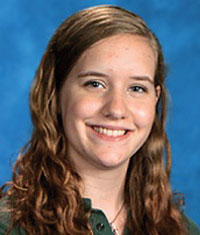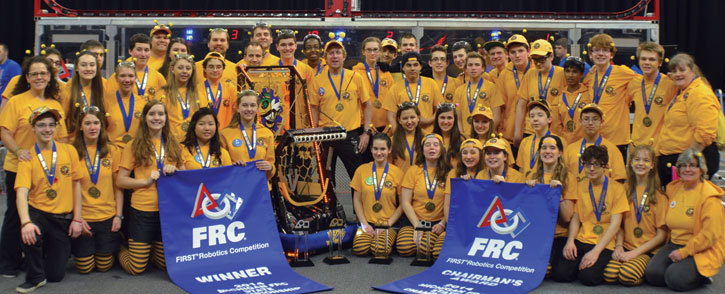After winning state title, Notre Dame’s robotics team finishes season with outstanding performance at world championship.
The Killer Bees pose with the state championship and Chairman’s Award banners after the April 12 competition at Eastern Michigan University.
Notre Dame Prep’s robotics team, the Killer Bees, was still basking in the glow of winning a state championship as they headed to St. Louis, Mo., for the World Championship of robotics where the team finished as a finalist in the championship, 8th in their division.
But it was on April 12, at Eastern Michigan University in Ypsilanti, when the Bees put together an exemplary strategy and along with an alliance that included Clarkston Rush Team 27 and Flint Team 314, won the Michigan FIRST Robotics championship and a trip to the world championships held this year on April 24-26. The team, which was founded in 1996 and last won the Michigan robotics championship in 2011, also earned the Chairman’s Award at this year’s state competition. The Chairman’s Award recognizes the team that best exemplifies the values of the FIRST organization. They also won the Chairman’s Award in 2009, 2010 and 2011.
Notre Dame senior Ellen Green, who has been a fixture on the school’s robotics team throughout her high-school career, says winning it all at the state level has been unbelievable. “After being a freshman when the team first won a state championship in 2011, I’ve been dreaming of that moment and I can’t think of a better way to end my senior year,” she said. “And the Chairman’s Award was a huge win for us because it’s a very prestigious award that focuses on community awareness and spreading the message of STEM (science, technology, engineering and math).”
WHAT IT'S ALL ABOUT
FIRST (For Inspiration and Recognition of Science and Technology) was founded in 1989 by noted inventor Dean Kamen to inspire an appreciation of science and technology in young people. Based in Manchester, New Hampshire, FIRST designs accessible, innovative programs to partner students and professionals to build self-confidence, knowledge and life-skills while motivating young people to pursue opportunities in science, technology and engineering.
From 28 teams in 1989, FIRST has expanded to more than 2,500 teams and 350,000+ students worldwide today. Teams from many other countries, including Brazil, Israel and Australia, competed with U.S. teams in the 2014 world championship event at the Edward Jones Dome in St. Louis.
Every year, FIRST designs a new robot “game” that is released in January. Teams then have six weeks to design and build a robot (weighing approximately 120 lbs.) that will compete against other robots. At a typical competition, teams are randomly matched with other teams and play 12 two-minute matches over two days. Teams pick up different partners and opponents for every match, which encourages team members to work together and help each other even off the playing field. FIRST has come up with terms for this unique form of competition: “coopertition” and “gracious professionalism.”
Regional events are usually held in university arenas and involve 40 to 70 teams cheered on by thousands of fans over two and a half days. The world championship event caps the season.
Referees oversee all competitions, and judges evaluate teams and present awards for design, technology, sportsmanship, spirit and commitment to spreading FIRST’s message: “science and math are fun.”
NOTRE DAME ROBOTICS DEEMED VITAL TO SCHOOL
Fr. Leon Olszamowski, s.m., head of schools for NDPMA, says that from very early when Notre Dame first opened in 1994, robotics was going to be a big deal on the Pontiac campus. “Science, engineering, math and technology have always been important to our country and to the world’s economic wellbeing,” he said. “So what better way to get the kids thinking about these things while they are still young than through this program. It’s been a great run for our school ever since.”
Notre Dame Prep senior Ellen Green has been a member of the Killer Bees for four years.
Heading into the 2011 season, the team received word that a major source of their corporate funding was being dramatically cut due to the still-floundering economy. With a major competition schedule looming, parents, mentors and the school’s advancement office put their heads together to see if they could find other sources of revenue to rescue the team. Students formed marketing teams to give presentations to companies and explained what FIRST is and how sponsoring the Killer Bees can benefit both the team and a sponsoring company.
The results were outstanding. The Killer Bees gained access to enough sponsor support to get them through that season. Currently, most of the corporate support has been restored. In fact, The Chrysler Foundation, which is Chrysler LLC’s community support arm, recently gave additional funding to the 12 robotics teams from Michigan that went to the World Championships in St. Louis.
ACCOLADES KEEP ADDING UP
Since 2011, the Killer Bees have strung together a huge list of wins and awards. Going into the state championship this year, the Bees were ranked sixth out of 277 participating teams in Michigan, according to Jim Zondag, one of the team’s mentors and a Chrysler engineer. “For the world competition, our chances of doing well are very good,” he said. “We are one of the highest scoring teams in the world, in the top 1%.”
In 2011, in addition to the state championship, the Bees won the Michigan Industrial Design Award, the IRI All Star Game, the Kettering Robot Quality Award and earned the highest match score in the world at the time with 160 points. In 2012, the team finished the season as the seventh-ranked team in the state, won the Industrial Design Award at the world competition, and was the number one-ranked Chrysler sponsored team in the state. The 2013 campaign was the team’s best season cumulatively at that time as the Bees finished the year with a record of 74-17-1 and was ranked 10th in the world. Going into the current season of competition, the Killer Bees had an overall historic record that put them sixth in the world.
IT TAKES A TEAM
Killer Bee Ellen Green said having the whole team (40 members) contribute is critical for achieving such success. “Teamwork is imperative while driving the robot on the field, but it also comes into play during the long hours we spend building the robot,” she said. “Over the course of our six-week build season, students may spend more than forty hours a week together. We become like a family. As the Bees always say: ‘Teamwork keeps the hive alive!’”
Along with mentor Zondag, a number of other adult volunteers contribute a whole bunch of their personal time to the Bees, including Sue McGinnis, a science teacher at NDP; Julia Green, Ellen’s mother, who works at Oakland Schools; Chrysler engineers Tim Grogan, Jim Soisson, Steve Hatfield and Dana Hobbs; and countless others equally devoted to the team’s success.
 Staying active in the community also is a big part of a typical year for the robotics team. Over the course of the past four years, the Killer Bees have participated in the Walk for Hunger, the Youth Engineering and Science Expo, the Plumber’s Union Fair, and the Rochester Christmas Parade. They’ve visited local childcare facilities, teaching young children about tools and demonstrating their robots, and they hold robot demonstrations around metro Detroit.
Staying active in the community also is a big part of a typical year for the robotics team. Over the course of the past four years, the Killer Bees have participated in the Walk for Hunger, the Youth Engineering and Science Expo, the Plumber’s Union Fair, and the Rochester Christmas Parade. They’ve visited local childcare facilities, teaching young children about tools and demonstrating their robots, and they hold robot demonstrations around metro Detroit.
Other special projects they’ve worked on include promoting the new Boy Scouts of America robotics merit badge and volunteering and raising money for the Children’s Leukemia Foundation. They also are a regular and visible presence on the NDPMA campus, demonstrating their robots at corn roasts, pep rallies, open houses, math and science classes and at lunchtime for fellow students.
School administrators and the rest of the student body have been important to the Bees’ success over the years, says Notre Dame senior Green. “NDP has been instrumental in our success as a team. Not only do we receive equal recognition with athletic teams, but the ‘it’s cool to be smart’ mentality has helped our team grow and achieve sustainability from year to year. The respect we have from the school and student body is tremendous and our team is very appreciative of the support.”
INVOLVEMENT BRINGS ADVANTAGES
As she heads to college after graduating Notre Dame, Green is confident that being a part of robotics is going to be a difference-maker for her. She said her involvement with FIRST robotics already has been an advantage for her on college applications as well as with the hands-on knowledge she’s gained from building and operating the machines. “As a prospective engineer, I feel very confident that my fantastic academic education from NDPMA paired with my technical knowledge from the Killer Bees will give me a real head start next year and beyond.”
Follow Notre Dame at @NDPMA.
About Notre Dame Preparatory School and Marist Academy
Notre Dame Preparatory School and Marist Academy is a private, Catholic, independent, coeducational day school located in Oakland County. The school's upper division enrolls students in grades nine through twelve and has been named one of the nation's best 50 Catholic high schools (Acton Institute) four times since 2005. Notre Dame's middle and lower divisions enroll students in jr. kindergarten through grade eight. All three divisions are International Baccalaureate "World Schools." NDPMA is conducted by the Marist Fathers and Brothers and is accredited by the Independent Schools Association of the Central States and the North Central Association Commission on Accreditation and School Improvement. For more on Notre Dame Preparatory School and Marist Academy, visit the school's home page at www.ndpma.org.

